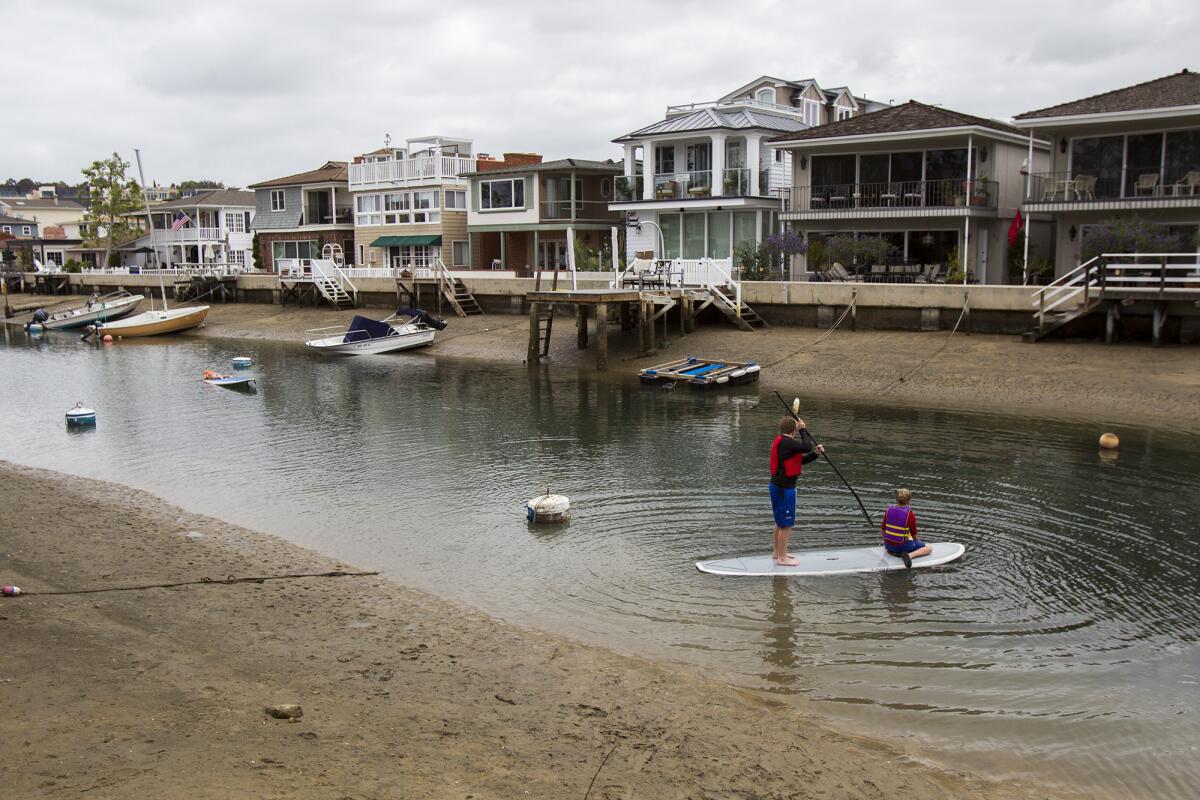Sea walls will be reinforced before dredging along Newport’s Grand Canal

Charlie and Carson Geiling paddle through the Grand Canal that runs between Balboa Island last year.
As Newport Beach prepares to dump sand along the sea walls surrounding Balboa Island’s Grand Canal, residents are wondering when their dream of a fully dredged waterway may become reality.
Since the Grand Canal was last dredged in the late 1990s, waterfront residents have watched as the white sand lining the passage sloughed away, transforming it to a stretch of slimy mud.
Decades ago, Balboa Islanders and visitors would place their beach chairs on the sand beside the Grand Canal to watch as their children hunted for crabs and seashells. Though the Grand Canal, which bisects the main island and Little Balboa Island, is still widely used by paddleboarders, boaters and families, people are not as inclined to sit there anymore, given its current state, residents say.
“It’s not how you’d like it to be,” said resident Don Abrams, who has asked the city for years to dredge the waterway.
Frequent dredging — removing fine-grain sand and debris — would refresh the Grand Canal, perhaps restoring its former glory, some say.
Mayor Ed Selich, who represents the area on the City Council, indicated during a July study session that he favored the city dredging the Grand Canal before reinforcing the sea walls with sand. With that in mind, some Balboa Island residents were puzzled when they received a notice last week that a city-hired contractor would be putting sand against the sea walls surrounding the Grand Canal before any dredging had been done.
The purpose of the sand, which the city extracted from the Santa Ana River, is to stabilize aging sea walls that are intended to protect harborfront property from flooding during storms and high tides. With forecasters anticipating strong storms and surf during El Niño conditions this winter, city leaders last month voted to authorize pouring sand into the Grand Canal to help stabilize some of the city’s oldest and most deteriorated sea walls.
“This is our effort to temporarily fortify the sea wall,” said Harbor Resources Manager Chris Miller. “We’re preparing as best we can to eliminate anything that could happen to the wall.”
Though city officials say they want to dredge the Grand Canal, they can’t begin until they have the necessary permits, which likely won’t happen for about a year. Historically, the process has been for the city to dredge and then build up the beach area with fresh sand. However, with El Niño storms coming, officials felt it was time to act.
“We can’t wait until we have a problem to put the sand up,” Selich said.
“I don’t know how long the sand will last, but I’m hoping it’ll last through the storm season,” Miller said.
Abrams said that while he understands the urgency, he believes the additional sand could make the dredging process harder.
“With time and storms, that sand will fall away from the wall,” he said. “It may make dredging more challenging later on.”
A major hurdle the city has faced with dredging the Grand Canal sits just below the water’s surface. Slender strands of green eelgrass, which is protected by state and federal law, have impeded the city’s ability to dredge the Grand Canal and other areas of the harbor for years.
Of the 90 acres of eelgrass throughout the harbor, about an acre is along the Grand Canal, according to city documents.
While eelgrass plays an important role in the development of suitable habitat for marine life, red tape surrounding its preservation has long frustrated those who spend time in the harbor.
The Southern California Eelgrass Mitigation Plan requires anyone who wants to dredge to be responsible for replanting 1.2 square feet of eelgrass somewhere in the harbor to make up for every square foot disturbed. The process is long and often costly, Miller said.
City officials expected to get some relief when the California Coastal Commission in June approved a city plan that would allow officials to not only dredge deeper in the harbor but also to disrupt a certain amount of eelgrass annually, depending on how much of the plant is in the harbor at the time.
However, Coastal Commission staff hasn’t issued the permit. And after the staff sends the document, the U.S. Army Corps of Engineers will have to sign off on the plan.
Miller said he originally hoped to have the plan in place by this month, but now he has his fingers crossed for January.
Still, the city eelgrass plan doesn’t necessarily mean the entire Grand Canal could be dredged at once, because, while the requirements would be lessened, the city still needs to mitigate eelgrass disruption.
“The overall bottom line is, we can’t use up the yearly amount impacting eelgrass in the Grand Canal,” Miller said.
Miller estimates it could take up to five years to have the canal dredged completely.
Wendy Friedman, who has lived on Balboa Island for about five years, said the Grand Canal should reflect the charming atmosphere of the island’s shops and harbor views.
“Our canal should be as beautiful as the rest of Balboa Island,” she said. “It has the potential to be spectacular.”